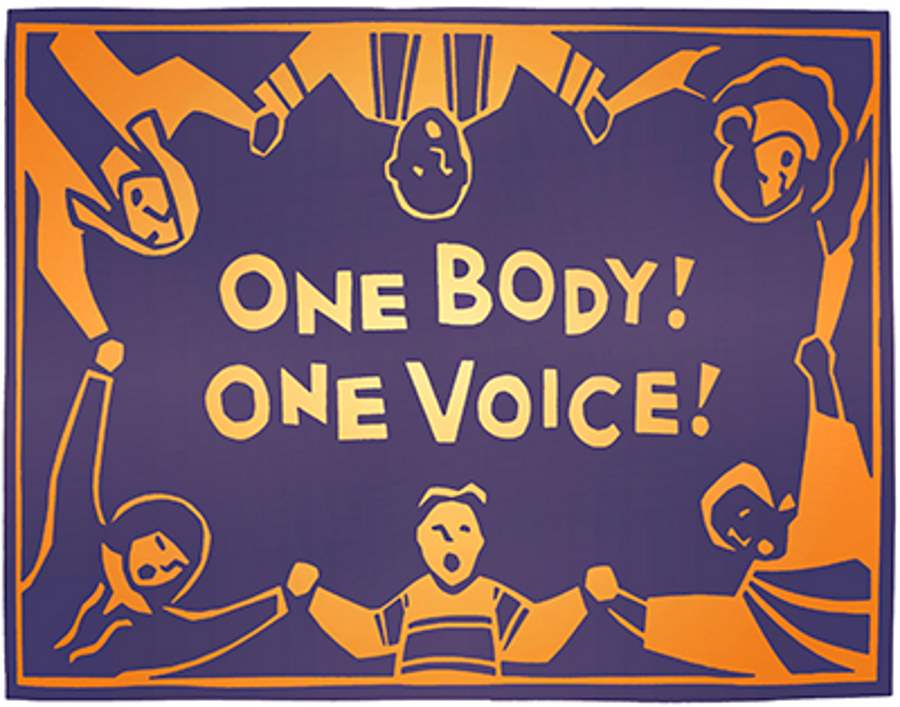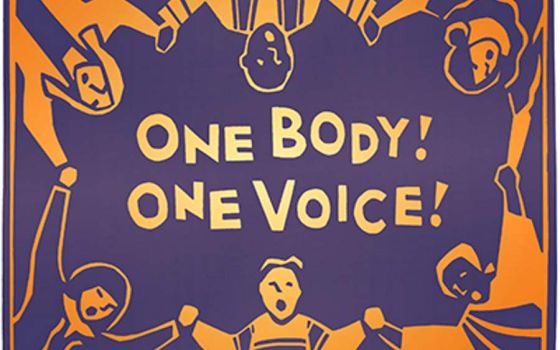
(Julie Lonneman)
At a time when division and polarization have come to characterize civil society and even churches, the celebration of the Lord's Supper stands as a sign of unity: "Because there is one bread, we who are many are one body, for we all partake of the one bread" (1 Corinthians 10:17, NRSV).
The Communion Rite of the Mass is filled with ritual elements that give expression to the unity of Christ's body, culminating in the procession of the assembly to the Lord's table and sharing in the one bread and the one cup. When the entire assembly joins in singing the Communion song that accompanies these actions, the sense of unity is strengthened.
Eucharistic sharing is fundamentally a communal action that both expresses and brings about the unity of Christ's body. Singing as we process to the Lord's table underscores this corporate nature of holy Communion and reveals the dynamism of Christ's body in the acts of walking, singing, eating and drinking.
Music is not extrinsic to the ritual action but is an integral part of it. In other words, the music for Communion is not merely background to accompany the procession and the distribution of Communion, but rather, in the words of the Second Vatican Council document, Sacrosanctum Concilium (The Constitution on the Sacred Liturgy): "as sacred song united to the words, it forms a necessary or integral part of the solemn liturgy" (#112). The singing of the entire assembly enriches the common actions of processing together and sharing the holy meal.
The Communion song that involves the entire assembly is a common thread that draws together the various elements of the rite. When properly chosen and prepared, the Communion song brings together the Communion of the priest, ministers and assembly as it extends from the invitation all the way to the conclusion of the procession. A song that includes a part for the entire assembly in alternation with choir or cantor is a concrete expression that all have a place in Christ's body where there is also a diversity of roles and gifts.
Singing by the entire assembly fosters deeper participation in Communion, and after all, "the full and active participation by all the people is the aim to be considered before all else" (SG #14). It is very much worth the effort for music leaders to prepare psalms, antiphons or other songs during Communion that will draw all more deeply into the mystery of Christ's dying and rising, awe and wonder at Christ's abiding presence, the abundance of God's generosity, the unity of Christ's body, and a spirit of joyful praise and thanksgiving.
Communal singing has the power to connect our hearts to these various dimensions of the Eucharist as we share in the banquet of the Lamb. Often the words of an antiphon or song may echo a key phrase from the Gospel or another Scripture reading of the day and strengthen the faith of participants who sing with their lips and take into their hearts the living word of God even as they receive him in holy Communion.
Choosing a Communion song should take account of the eucharistic action itself, the occasion being celebrated, and the community that is singing and celebrating. The text of the Communion song may relate to the action of sharing the holy gifts of Christ's body and blood. The U.S. Conference of Catholic Bishops in their 2007 document, "Sing to the Lord: Music in Divine Worship," write that these songs should reflect "themes of joy, wonder, unity, gratitude, and praise" (#194).
Just as the Communion antiphons are usually related to feast or season and often echo the Gospel reading of the day, so too music planners should consider Communion songs that take these elements into account. For example, during the later part of the Easter season, when the Scripture readings so frequently highlight Jesus' command that we love one another, it would be appropriate to select a text that reflects this theme, including various settings of "Love One Another" or "Ubi Caritas."
Advertisement
To foster the active participation of the assembly in singing, communities need a repertoire of familiar and beloved Communion songs with refrains that can be sung by heart. Consider incorporating some of the best known and theologically rich texts, including "Gift of Finest Wheat," "I Am the Bread of Life," "One Bread, One Body," "Taste and See," and "Eat This Bread."
Communal singing during Communion is often lackluster at best. In some ways, this lack of active participation mirrors the divisions that afflict the body of Christ and the exclusion of many from the Lord's table. The failure of Christians to live what they celebrate is surely a scandal and an obstacle to the full preaching of the Gospel. Yet, just as the Church continues to celebrate the eucharistic feast even as it falls short, so, too, should pastoral musicians persist to foster communal singing as a sign of that unity for which Christ prayed, and for which we still long.
Editor's note: This reflection was originally published in the May 2019 issue of Celebration. Sign up to receive daily Easter reflections.








